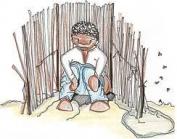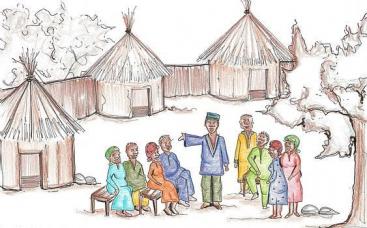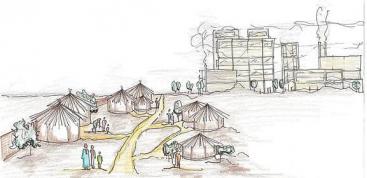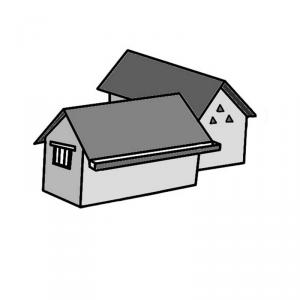Executive Summary
Within the planning process, it is of prime importance to collect baseline data in order to determine the requirements for an appropriate sanitation and water system in the project area. The collected background information will provide the basis for the software or hardware intervention. The planning process should be accomplished in participatory and comprehensive manner. Conducting an integral evaluation and collecting technical information on the existing systems are the first steps within this process. These steps are followed by a comprehensive identification of the socio-economic situation as well as external factors.
Note: To know where to start when you collect baseline data, it may be helpful if you first carry out the understand your system exercise.
Introduction

Integral description of settlement conditions through a participatory approach. Source: NETSSAF (2008)
The purpose of the baseline data collection within the planning procedure is to collect background information that is essential to determine the requirements for an adequate sanitation and water project – both from a technical point of view, and from the user’s perspective. The gathered information will provide the details necessary for the design of the project (e.g. do you have to focus more on software? Or which technical tools are needed?).
Ideally, this planning step should be conducted through a comprehensive, participatory evaluation of the current level of services and the perceptions of the users towards sanitation and water within the project area (see also exploring). The objective of this approach is not only to facilitate participatory decision making in the planning process, but also to improve further designs to meet user needs and to face the operation and maintenance challenges of day-to-day service delivery (adapted from NETSSAF 2008).
According to NETSSAF 2008, the description of settlement conditions can be accomplished successfully by including the following three aspects in the process of data collection:
1. Gathering of Technical Information on Existing Systems
The technical information on the existing sanitation and water system should be gathered through an analysis in order to understand the status of the various flow-streams in each domain (see also material flow analysis). The main objective is to collect information regarding the area’s sanitation and water systems and their level of integration in the settlement structure. Technical requirements for the proposed system will depend on a thorough assessment of information regarding excreta and solid waste disposal practices, water supply, water availability, wastewater treatment, drainage, and fertilisation/crop production practices in the area. The technical information on the existing system should cover issues such as (NETSSAF 2008):
- Inventory of existing household level sanitation and water technologies, hygiene practices, fertiliser use, and their perceived benefits.
- Description of the conditions of the existing sanitation and water system as well as their operation and maintenance procedures.

Identification of existing water and sanitation practices. Source: NETSSAF (2008)
This initial survey will allow finding out what services are in place, and what are the user perceptions of the services. It is important to develop a questionnaire which can be applied in semi structured interviews to the members of the community. Furthermore, it is recommended to contact key staff of relevant departments of the municipality, such as the water supply agency or the civil works department. It might be possible that site plans showing the existing infrastructure (sewer lines, inspection chambers, location of sewage treatment plants, potable water lines, water plan, etc.) are already available in the Municipal Ward. These maps will facilitate to have a clearer picture of the situation. Furthermore, it is also of primal importance to identify and collect detailed information regarding future plans for extending or upgrading infrastructure within the municipalities (adapted from EAWAG 2005).
2. Identifying the Socio–Economic Situation of the Settlement

Definition of the socio-economic situation of the settlement. Source: NETSSAF (2008)
The system requirements will also depend on the social and economic situation of the settlement which therefore has to be identified (see more exploring tools. In designing feasible sanitation and water systems it is necessary to understand the user perceptions regarding sanitation and water infrastructure, their hygiene practices, economic possibilities and priorities, as well as to analyse how the existing institutional framework will affect decision making. In determining requirements for management and operation of the system it is also of interest to identify the stakeholders’ capacities (e.g. know-how, skills, manpower, equipment, financial resources). The sanitation and water planning team will collect information through stakeholder workshops (see also stakeholder analysis) and field studies, and report on issues such as:
- Description of local physical conditions (e.g. population size, density, etc.).
- Assessment of the community’s resources, literacy and education level, land ownership, farming practices, and occupations.
One key component within the sanitation and water system is the design for the reuse of products which needs to be started parallel to the planning of the sanitation and water infrastructure. Among the most important factors to be considered are the quantity, quality and types of products as well as the farmers' needs for application. Especially in peri-urban areas, it is of prime importance to determine the settlement patterns, population density, communication routes, conditions of the roads, etc., in order to plan the transport logistics of the sanitation products to the agriculture fields. It is essential to think holistically taking into account all the aspects involved in the reuse chain.
3. Identification of External Factors

Identification of external factors. Source: NETSSAF (2008)
Within the integral description of settlement conditions, the assessment must look beyond sanitation and water issues to identify the external factors that drive decision making within the community and understand how they can be accounted during the planning process. This includes not only the physical state of local water resources, but also the relevant legislation existing policies and current management activities. Further external factors include:
- Local conditions (temperature, humidity, rainfall and its variation, evapotranspiration).
- Soil/ground conditions (type of soils, infiltration capacity, geology, topography).
- Water related characteristics (flooding, source of water, groundwater (risk of contamination)).
- Institutional factors (decision making power at local level).
How to Conduct a Baseline Assessment?
Information for the baseline assessment can be obtained from a wide variety of sources and should roughly focus on the following categories (PHILIP et al. 2008):
- The local water resources and sanitation situation, including the assessment of the quantity and quality of the local surface and groundwater sources, rainfall rates, average and peak demands, services available etc.
- Water and sanitation legislation, such as water acts and licencing practice (see also policies and legal framework).
- Key stakeholders, such as individuals and representatives of groups who will be invited to participate in the development of the local action plan.
- Water management and sanitation activities and institutions, such as completed and ongoing projects and the existence and roles of institutions that deal with water management and sanitation – and don’t forget agriculture (in terms of reuse).
PHILIP et al. (2008) propose the following methodology for a successful baseline assessment:
- Compilation of a list of information sources: The drafting of a list of institutions, organisations and any other sources that might provide useful information for carrying out a baseline assessment.
- Collection of secondary information: Collection of information that is already available from the archives and data stores of the municipalities as well as from identified external institutions and organisations. This should provide a good understanding of the current water resources and sanitation situation both physically, in terms of quality, quantity and patterns of demand, and legally, with regard to legislation and policy.
- Collection of primary information: Collection of information through, for example, investigations to fill information gaps on the local infrastructure and water/sanitation environment, and discussions with the local community to highlight existing concerns, such as health problems, that might be related to local water resources and sanitation.
- Storage of information: Ensuring that information is properly documented and stored in a systematic and structured way. Ideally this should be done in an electronic database. However, it is also possible with a well-organised and maintained paper filing system.
- Providing access to information: Providing other government departments with easy access to the compiled information and, externally, allowing civil society to benefit from the growing amount of knowledge.
Media and public relations work: Announcement of the intention to carry out a baseline assessment in order to raise public awareness of the reasons for the collection of information and encourage people to get involved (see also awareness raising or media campaigns).
Before implementing a water or sanitation project in your area, you have to collect some baseline data. Within the planning procedure, collecting background information is essential to determine the requirements for an adequate sanitation and water system from both technical and user perspectives. The gathered information will provide the technical details necessary for system design and identifying and prioritising community needs related to water and sanitation issues
Household-Centred Environmental Sanitation, Implementing the Bellagio Principles in Urban Environmental Sanitation – Provisional Guideline for Decision Makers
This guideline for decision-makers has been developed to provide first guidance on how to implement the Bellagio Principles by applying the HCES approach. Assistance is given to those willing to include and test this new approach in their urban environmental sanitation service programmes. Since practical experience with the HCES approach is lacking, this guideline is neither comprehensive nor final, but will have to be developed further on the basis of extensive field experience. Available in English, French and Spanish.
EAWAG (2005): Household-Centred Environmental Sanitation, Implementing the Bellagio Principles in Urban Environmental Sanitation – Provisional Guideline for Decision Makers. Geneva, Switzerland: Swiss Federal Institute of Aquatic Science and Technology URL [Accessed: 17.06.2019]NETSSAF Participatory Planning-Approach
This is the actual tutorial of the participative planning approach developed by NETSSAF, containing all the steps, sub-steps and case studies. It is freely available on the internet in French and English.
NETSSAF (2008): NETSSAF Participatory Planning-Approach. A tutorial for sustainable sanitation planning. Network for the Development of Sustainable Approaches for Large Scale Implementation of Sanitation in Africa (NETSSAF). [Accessed: 29.03.2010] PDFLocal Government and Integrated Water Resources Management (IWRM) Part III: Engaging in IWRM – Practical Steps and Tools for Local Governments
The set of materials entitled “Local Government and Integrated Water Resources Management (IWRM)” aims to assist Local Governments with active participation in IWRM. The materials are primarily targeted at local government officials, but are considered equally useful for individuals and organisations that work with local governments in the management of water resources.
PHILIP, R. ANTON, B. BONJEAN, M. BROMLEY, J. COX, D. SMITS, S. SULLIVAN, C. A. NIEKERK, K. van CHONGUICA, E. MONGGAE, F. NYAGWAMBO, L. PULE, R. BERRAONDO LOEPEZ, M. (2008): Local Government and Integrated Water Resources Management (IWRM) Part III: Engaging in IWRM – Practical Steps and Tools for Local Governments. Freiburg: ICLEI European Secretariat GmbH URL [Accessed: 17.04.2012]Sanitation Marketing Dashboard
Consultant-led sanitation marketing surveys typically take months to produce a thick report with largely impractical recommendations. The IRC International Water and Sanitation is developing a field tool that delivers, within just one week, a one-page overview matching sanitation supply and demand. The tool, a sanitation marketing dashboard, was tested in two unions covered by the BRAC WASH II programme in Bangladesh.
BAETINGS, E. (n.y): Sanitation Marketing Dashboard. The Hague: IRC International Water and Sanitation Centre URL [Accessed: 02.10.2018]NETSSAF Participatory Planning-Approach
This is the actual tutorial of the participative planning approach developed by NETSSAF, containing all the steps, sub-steps and case studies. It is freely available on the internet in French and English.
NETSSAF (2008): NETSSAF Participatory Planning-Approach. A tutorial for sustainable sanitation planning. Network for the Development of Sustainable Approaches for Large Scale Implementation of Sanitation in Africa (NETSSAF). [Accessed: 29.03.2010] PDFLocal Government and Integrated Water Resources Management (IWRM) Part III: Engaging in IWRM – Practical Steps and Tools for Local Governments
The set of materials entitled “Local Government and Integrated Water Resources Management (IWRM)” aims to assist Local Governments with active participation in IWRM. The materials are primarily targeted at local government officials, but are considered equally useful for individuals and organisations that work with local governments in the management of water resources.
PHILIP, R. ANTON, B. BONJEAN, M. BROMLEY, J. COX, D. SMITS, S. SULLIVAN, C. A. NIEKERK, K. van CHONGUICA, E. MONGGAE, F. NYAGWAMBO, L. PULE, R. BERRAONDO LOEPEZ, M. (2008): Local Government and Integrated Water Resources Management (IWRM) Part III: Engaging in IWRM – Practical Steps and Tools for Local Governments. Freiburg: ICLEI European Secretariat GmbH URL [Accessed: 17.04.2012]Baseline Study on Water Supply, Sanitation and Solid Waste in Upper Dharamsala, India
This study on water supply, sanitation and solid waste in upper Dharamsala represents a case study how to conduct an integral description of the settlement conditions within the planning process. The document provides a comprehensive description of the conditions related to sanitation, water and solid waste in Dharamsala.
STERKELE, B. ZURBRUEGG, C. (2003): Baseline Study on Water Supply, Sanitation and Solid Waste in Upper Dharamsala, India. Duebendorf: SANDEC, EAWAG URL [Accessed: 02.10.2018]http://www.netssaftutorial.com/
This site of the NETSSAF tutorial contains various documents related to the process of describing the settlement conditions in your project area. These documents can support you in your planning process and act as examples and case studies. This website contains the following documents a) A check-list of water and sanitation services conditions b) A check-list of the demographic and cultural, economic and financial, institutional and health aspects c) A check-list of the climatic and soil characteristic d) Further Readings about assessment of current status e) Guidelines for carrying out an assessment of current status f) Review of the existing participatory sanitation planning g )Materials to prepare your team for community field work and community mapping.

